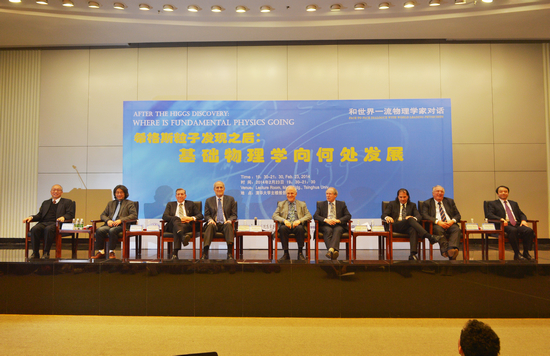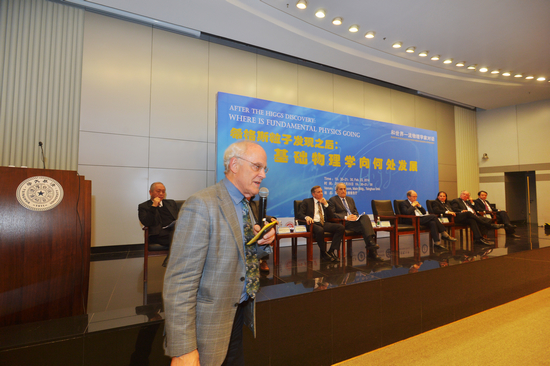Scientists aim at next-generation high energy circular collider
Nine world leading physicists had face-to-face discussions at Tsinghua University, Beijing on Feb 23, Top physicists have face-to-face discussions on future of fundamental physics(image by LIU Jie, IHEP)
sharing with the public their opinions on new physics opportunities after the discovery of Higgs.

Chaired by Shing-Tung Yau, a Fields medalist, the panel discussions involves a group of noted scientists, Nima Arkani-Hamed, David Gross, Gerard 't Hooft, Joseph Incandela, Luciano Maiani, Hitoshi Murayama, Yifang Wang and Edward Witten, who are either Nobel laureates or Fields medalists and Fundamental Physics Prize winners.
Proposed by the Chinese high energy physics community in 2012, the circular electron positron collider (CEPC) has got warm responses from the international community. The next-generation high energy circular collider could be upgraded to a future circular high energy proton-proton collider beyond the Higgs factory.
The main physics objectives of the future high energy circular accelerator are the precise measurement of Higgs properties as well as exploring the more elementary physics laws beyond the Standard Model.“Only after we have understood the properties of the Higgs particle could we find the direction of future particle physics research” introduced Wang Yifang, Director of the Institute of High Energy Physics and the winner of the 2014 W. K. H. Panofsky Prize in Experimental Particle Physics.
Nima Arkani-Hamed, the winner of the 2012 Fundamental Physics Prize commented that the only method to explore the micro-world is to build a larger circular accelerator. The first step could be an electron-positron-collision experiment and the second step could be proton-proton collision at a higher energy range. Then we could observe the world at a more microscopic scale.
The world leading scientists agree that this is a good timing and opportunity for China to build the circular collider. They believe that the future circular collider would promote China to the leading position in the international high energy physics community and bring unprecedented influence to our recognition of the Higgs particle and the nature.
David Gross, Nobel Laureate in Physics believes that the future circular collider, which he calls “the Great Accelerator”, could be compared to “the Great Wall” in China. If China built the collider, scientists from all around the world would join and work together. New breakthroughs and discoveries could be achieved in the future.
From February 24 to 25, a two-day workshop focusing on the physics case for future circular colliders, as well as discussions on how to synchronize the domestic theoretical particle physics efforts with the planning and designing of future circular machines will be held at the Institute of High Energy Physics.

Wang Yifang, Director of the Institute of High Energy Physics and the winner of the 2014 W. K. H. Panofsky Prize in Experimental Particle Physics introduces CEPC(image by LIU Jie, IHEP)

Nima Arkani-Hamed, the winner of the 2012 Fundamental Physics Prize at the panel discussions (image by LIU Jie, IHEP)

David Gross, Nobel Laureate in Physics at the panel discussions (image by LIU Jie, IHEP)